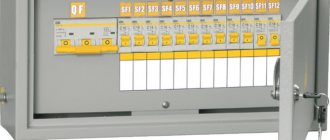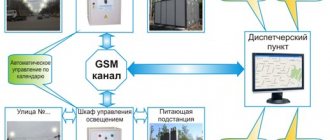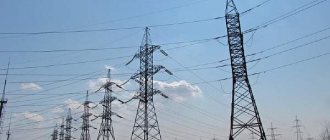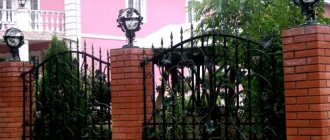What should urban lighting be like?
External lighting of urban areas is one of the most important elements of creating comfortable living conditions in a populated area. Despite the supposed spontaneity of this aspect, lighting in the city is subject to a number of norms and rules. These include construction standards, lighting standards, and PUE standards.
But each of these elements provides only a fragment of the requirements for urban lighting. We will try to combine all these standards to create a holistic image of the correct installation of lighting in the city.
City lighting standards
Urban street lighting can be divided into two components - road lighting and pedestrian area lighting. It is clear that each of these components has its own standards, which are collected in SNiP 23 - 05 - 95.
Road lighting
What determines the brightness of road lighting? To answer this question, let's look at what factors can influence this indicator.
Traffic volume on the motorway
- First of all, of course, this is the intensity of road use. That is, the number of cars that pass along it within an hour. As the instructions say, this indicator is conditionally divided into 4 categories. These are highways that carry more than 3,000 cars per hour; highways - the load on which is from 3000 to 1000 cars per hour; roads that carry between 500 and 1,000 vehicles per hour, and roads that carry less than 500 vehicles per hour.
- But it is not only traffic intensity that determines the priority of the road. Agree, highways should be illuminated much better than small local roads. Even if the traffic intensity on this highway is not so great. Or, for example, the main streets of cities in the historical part of settlements, which have been specially relieved of traffic flow, should be better illuminated than roads of the same intensity in other areas of the city. After all, they must correspond to the general level of illumination on the street.
Categories of highways
- All these are rather conditional parameters and relate more to issues of urban planning. In this regard, in this matter, SNiP 23 – 05 – 95 refers to SP 42.13330.2011, which in Table 7 establishes the requirements for streets and roads for various purposes. SP 42.13330.2011, in turn, refers to SNiP 2.05.02-85, which establishes categories of highways.
Categories of highways according to SNiP 2.05.02-85
- Based on these two conditions, Table 11 SNiP 23 – 05 – 95 sets lighting standards for various types of roads. They range from 4 to 20 lux. At the same time, not only the average illumination is normalized, but also the average brightness of the surface, which varies from 0.2 cd/m2 for local roads with single cars, to 1.6 cd/m2 on highways with heavy traffic.
- But the lighting scheme for cities should include good lighting at the intersections of different types of roads. That is, if a highway and a local road intersect, then the lighting at the intersection should be done as for lighting the main road. The same applies to highway exits.
Road lighting standards
- A separate issue is the ratio of minimum to average brightness. Pay attention to the middle one. So for the road as a whole this ratio should not exceed 0.35. For one lane, this difference should not exceed 0.6.
The video talks about how street lighting works in Moscow.
Lighting standards for pedestrian areas
City lighting for pedestrians is much more difficult to relate to street congestion. Therefore, lighting requirements are usually tied to the significance of the settlement, as well as individual streets in it.
But there are also park areas, squares, utility areas, local areas and much more that should also be illuminated. Therefore, with the lighting of pedestrian areas, everything is a little more complicated.
Note! Here and below we present the average illumination value. The norms for the ratio of minimum to average lighting for pedestrian areas are the same as for highways.
| Let's start our conversation with pedestrian areas adjacent to roads. If these are central streets, then the illumination here should be at least 10 lux. If they are separated from highways, then the illumination can be reduced to 4 lux, and for local streets to 2 lux. |
| For stops and other places where passengers board and disembark, the illumination standard is 10 lux. The same rule applies to pedestrian bridges. But for pedestrian crossings, the illumination during the day should be 100 lux, in the evening and at night it should be reduced to 50 lux. This is done to eliminate the glare effect. |
| As for lighting the territory of microdistricts, the main paths must have an illumination of at least 4 lux. Secondary approaches are only 2 lux. But children's playgrounds must have normal lighting. It should be at least 10 lux. |
| As for recreational places, such as citywide or local parks, stadiums, exhibitions, the required lighting parameters here fluctuate quite a lot. For example, the central entrance to a city-wide park should be illuminated at least 6 lux, to a stadium 10 lux, and to a local park only 4 lux. The same applies to auxiliary entrances, alleys and recreation areas. All these values are summarized in Table 14 SNiP 23 – 05 – 95. |
| Separate standards exist for rural roads and streets, lighting around public buildings, child care facilities, parking lots, gas stations and other infrastructure. It makes no sense to analyze each of these standards because most of them range from 10 to 2 lux. |
Examples and ideas for road and street lighting
Modern street lights add a touch of architectural design to street and road lighting without compromising safety or code compliance.
- Related Posts
- We'll tell you all about lamp sockets
- What glow (color) temperature to choose.
- What are fluorescent fluorescent lamps and what are they?
Principles of constructing street lighting
If you think that organizing city street lighting is easy, then you are deeply mistaken. After all, when creating urban lighting, designers must take into account not only the required lighting parameters.
The calculations take into account such indicators as: graininess and the reflected component of the asphalt pavement, dustiness of streets, amount of precipitation, width of streets, surrounding colors, light noise and much, much more. And all this is based on the concept of city development for the next 10 years.
One-way road lighting scheme
- Of course, we will not discuss each of these criteria. Indeed, to fully cover this topic, research institutes compose entire treatises. And you cannot build such systems with your own hands. But we will focus on the main aspects of the construction principle.
Double-row staggered arrangement of lamps
- Let's start with road lighting. It can be done in two ways - by installing lamps on special supports and by hanging lamps on cables.
- Which scheme and where to use is decided by calculation. One of the main parameters in this calculation is the width of the road surface. Thus, with a road surface width of up to 12 meters, it is recommended to use a one-sided installation scheme for lamps on poles. For widths up to 18 meters, it is recommended to use a two-row system with a staggered arrangement of lamps on poles. With a width of up to 32 meters, a rectangular checkerboard pattern.
Double row lighting system
- If we have a dividing strip between traffic lanes, as in the video, then when the width of the road in one direction is up to 12 meters, it is recommended to use a two-row lighting system - this is when the lamps are installed on poles, and one lamp illuminates one lane of traffic, and the second the second.
Road lighting schemes
- As for hanging lamps on cables, a single-row scheme is recommended for roads with a width of up to 18 meters. For roads up to 36 meters wide, it is recommended to use a two-lane layout.
Note! All this is nothing more than recommendations of a regulatory document. The final choice of lighting design is made based on the calculation and ease of maintenance of such lamps.
- An important component of the city lighting scheme is the proper level of light above intersections, pedestrian crossings and crossings. Certain recommendations have also been developed for them. Thus, to illuminate pedestrian crossings, one lamp is installed on each side of the road. Moreover, they should be located to the right of the pedestrian crossing the road. The distance between these lamps should be 1.5 times the width of the road.
Lighting scheme for road curves, crossings, intersections and pedestrian crossings
- As for the lighting of squares, park areas, pedestrian paths and other recreation areas, paragraph 10.16 SNiP 2 - 4 - 79 recommends that it be carried out with an emphasis on the architectural and artistic appearance of the city. It is recommended to make maximum use of brackets, public transport contact connections and other installation locations for luminaires to minimize the use of poles.
Muscovites were afraid of gas lamps
In the middle of the 19th century, alcohol-turpentine lanterns appeared, then kerosene ones. The evening streets of Moscow became lighter, shop windows looked more enticing. Muscovites began to dress smarter when going out in the evening.
In 1865, the Moscow City Duma signed a 30-year contract with the English for the installation of gas lighting in the city. The company built a plant, laid a gas pipeline and installed three thousand gas lamps. The British coped with the task, but then began to suffer losses. One of the main problems was that the company initially announced a very low price for the street lamp - 14 rubles 50 kopecks.
“The British thought that there would be many private consumers and at their expense the company would cover the costs of street lighting. However, they were wrong. Russian people were very afraid of gas. They were afraid that it might explode, that it might cause poisoning. Some Muscovites did not understand how air could burn without a wick. As a result, there were too few people willing to light their houses with gas,” notes Natalya Potapova.
Street lighting control
All road and city lighting must have a unified centralized control system. If there are large distances between objects or if there are natural obstacles, they can be divided into regional lighting control schemes. But in any case, they must have centralized control via telephone or radio communication.
Outdoor lighting control schemes
- According to PUE standards, city lighting can be controlled automatically. But at the same time, in any case, the possibility of forced manual control of lighting must be ensured. This is necessary to carry out repair work, in case of malfunction of automatic control systems and in case of emergency situations.
Tunnel lighting
- The city's lighting scheme should be two-level if we have objects such as underground passages, tunnels and others that belong to the second degree in terms of power supply reliability. The second level means that cutting off the power supply to such facilities is unacceptable. All other lighting in the city belongs to the third level of reliability.
- A two-level control system means that some of the lamps work during the day, and some both during the day and at night. A three- or more-level control system is possible. The main factor here is the price, which is slightly higher for multi-level systems.
Controlling the inclusion of individual lamps
- A multi-level lighting control system is also allowed for city lighting systems. But at the same time, according to clause 6.5.25 of the PUE, simultaneous switching off of two adjacent lamps is not allowed. That is, late at night, to reduce consumption, it is allowed to turn off up to 50% of the city lighting.
Outdoor lighting cabinet
- External lighting of adjacent areas, as well as areas in front of public buildings, is controlled from these buildings. To do this, they must have a special outdoor lighting panel. Do not connect to it, you can only use a lamp above the entrance to the building. It can be connected to intra-house networks.











